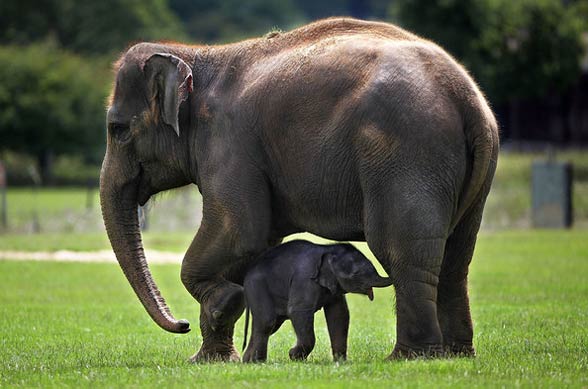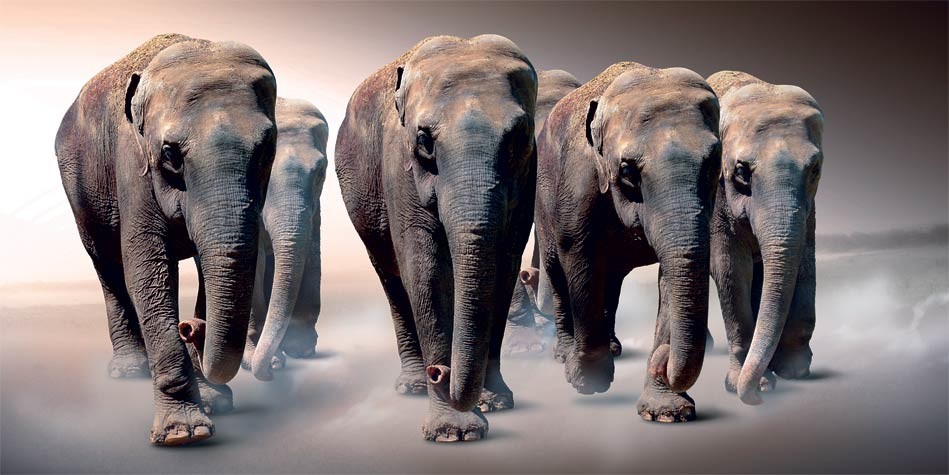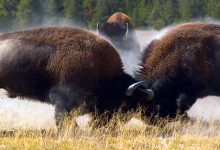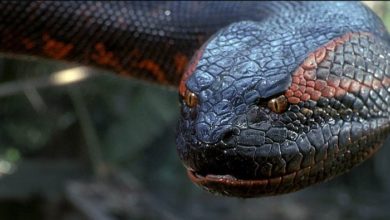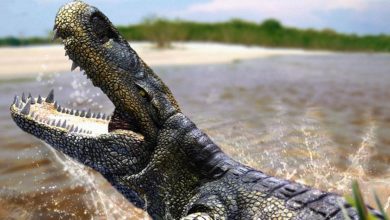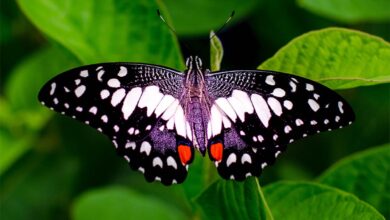Asian elephant (Elephas maximus)
A smaller, but certainly not worse, cousin of the African elephant (Loxodonta africana). It has unique skills and capabilities, thanks to its anatomical structure and character. Although it’s less focused on a family, it can show emotions and surprises with its intelligence.
Classification
- Class: Mammalia
- Order: Proboscidea
- Family: Elephantidae
- Genus: Elephas
- Species: Asian elephant (Elephas maximus)
This classification includes 3-4 subspecies of the Asian elephant:
- Sri Lankan elephant (Elephas maximus maximus) – inhabits Sri Lanka
- Elephas maximus indicus – is found in India, Nepal, Bhutan, Burma, Thailand, Malay Peninsula, Laos, China, Cambodia, and Vietnam
- Indian elephant (Elephas maximus bengalensis or indicus) – inhabits mostly India
- The Malay Race of the Indian Elephant (Elephas maximus hirsutus) – inhabits the Malay Peninsula
- Sumatran elephant (Elephas maximus sumatranus) – as the name suggests, it inhabits Sumatra (Greater Sunda Islands)
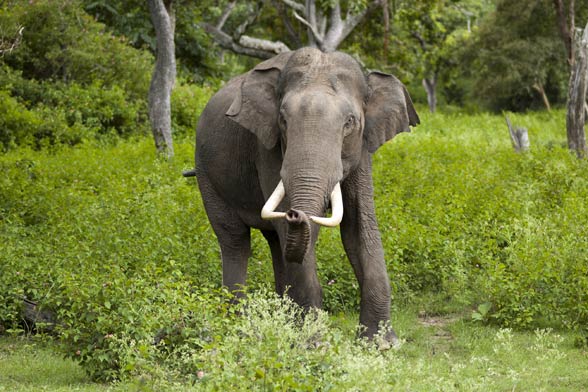
Name
Asian or Indian elephant?
The name may be slightly misleading. In the English nomenclature, Elephas maximus means the Asian elephant; Elephas maximus indicus is the subspecies found in India – the Indian elephant.
Environment
These elephants prefer meadows, tropical evergreen forests, moist and dry deciduous forests, thorn forests, and scrublands as their habitats. They are found in areas at altitudes over 3,000 m. In summer, in the Eastern Himalaya (north-eastern India), they regularly move up those altitudes.
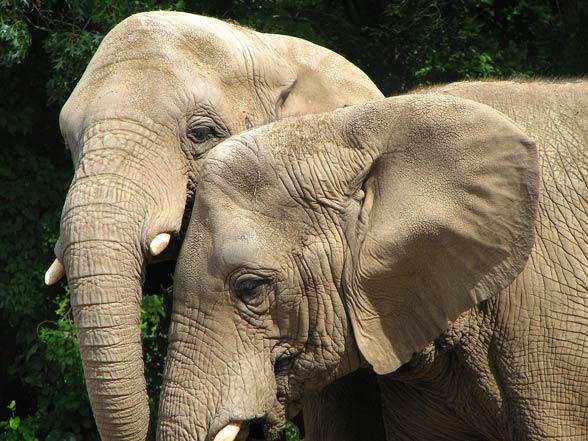
Characteristics
Appearance
The Asian elephant is smaller than the African elephant. Moreover, its head is more pointed, ears smaller, and the rump descendent. It has 20 pairs of ribs and 34 caudal vertebrae. There are 5 nail-like structures on each forefoot, and 4 on each hind foot.
Size
Although the Asian elephant is not as large as the African elephant, its size is impressive anyway. The average height at shoulders in bulls rarely exceeds 2.7 m (8.85 ft), and 2.4 m (7.9 ft) in females. It weighs about 2.7 t (5950 lb), and individuals of the weight of over 4.16 t (10,140 lb) are rarely found. The last found record male weighed 5.4 t (11,900 lb) with the height at shoulders of 3.2 m (10.5 ft). The body length ranges between 5.5 and 6.5 m (18 and 21 ft), with the tail that is 1.2-1.5 m (3.9-4.9 ft) long.
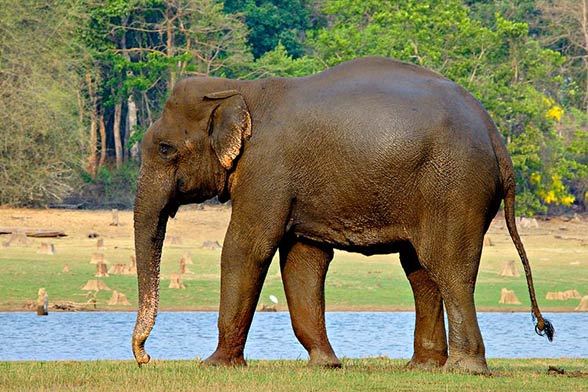
Why does the Asian elephant have smaller ears than the African elephant?
The ears of the Asian elephant are much smaller than these of its African cousin. It is because they are not used for thermoregulation – Asian elephants hide from the sun in shaded forests, while African elephants have no such option.
Trunk
As all elephant species, the Asian elephant has also, instead of a nose, a long trunk combined with the upper lip. At the end of this specific organ, there is a single finger-like process located near the nostrils (the African elephant has two processes). The trunk is a very sensitive and wiggly part of the body, which is used for grasping food and other items, watering, breathing, making sounds, communicating, touching, defense and fight.
The trunk is not the only organ responsible for great smell, Jacobson’s organ is the other one. The trunk length ranges between 1.5 and 2 m (4.9 ft and 6.6 ft) or more, depending on the subspecies and age of a given individual. The muscles and tendons, combined with great coordination, provide this useful organ with great grip and agility. Thanks to the trunk, the Asian elephant can playfully poke other individuals, however, usually it is used for non-verbal communication and fights.
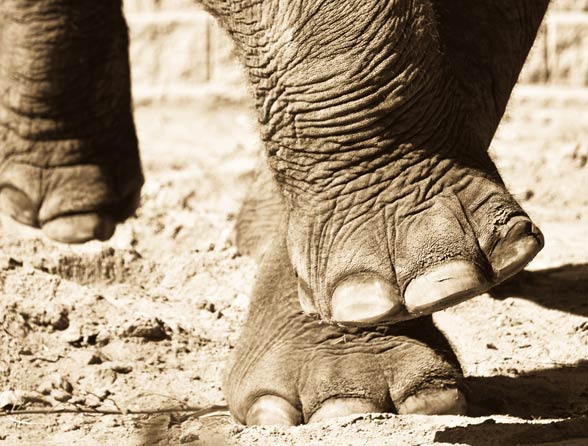
Tusks
Tusks serve as shovels used for digging in the ground and breaking thick branches. Thanks to them, the animal marks tress, defends itself and attacks, and protects its trunk from injuries.
Female Asian elephants have no tusks, and if they do, the tusks are hardly visible, only when the jaw is open.
From time to time, it happens that adult males lack tusks as well, it occurs mostly in the Sri Lankan elephant. The situation is different when it comes to the African elephant – both sexes have magnificent, beautiful tusks.
On the forehead, there are two domed bumps, which distinguishes the Asian elephant from the African elephant significantly.
Agile limbs
Limbs play an important role in daily life – while the African elephant uses them for digging or grabbing soil, the limbs of the Asian elephant are very agile, and, what is the most interesting, the animal can use them for manipulating objects!
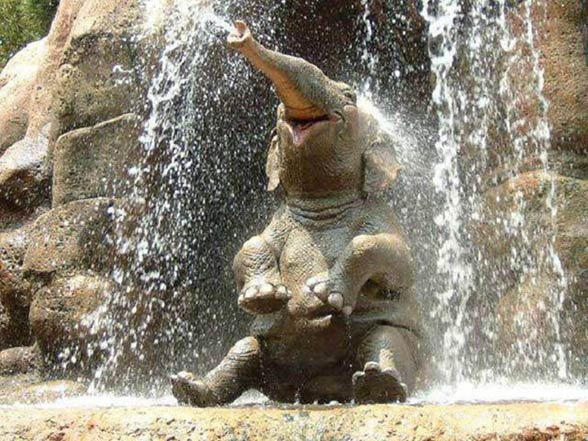
Skin
The skin is usually greyish, although it becomes of the color of soil in which the elephant rolls around. The skin is wrinkled and highly innervated, but smoother than the skin of African elephants, and it tends to be depigmented on the ears, neck and trunk.
The average thickness on the back is about 30 mm (1.18 in), protecting the elephant from injuries, bites, and unfavorable weather conditions. Folds increase the skins surface, which facilitates heat dissipation. Therefore, the animal has better tolerance for cold than for heat.
Intelligence
As their relatives, Asian elephants are very intelligent and self-conscious. This is reflected by the brain structure – a large and highly convoluted neocortex, that is also a characteristic feature of humans, apes and some dolphin species.
The Asian elephant can process information well; cognitive processes are more complex than in apes that are most closely related to human. Many times it has been observed how herds of Asian elephants moved to safer areas in times of natural disasters, such as tsunamis or earthquakes.

Lifestyle
Diet
The Asian elephant feeds at dawn or dusk, eating up to 150 kg (330.69 lb) of plants daily. It is both grazer and browser. On the basis of observations, it has been shown that the menu of the Asian elephant includes about 112 plant species, out of which the animal prefers Malvales, legume, palms, sedge and true grass. In the dry season, it enriches its diet with bark. The Asian elephant drinks water once a day and is always around a source of fresh water. During a day it uses 80-200 l (21.13-52.83 US gal)for drinking and bathing.
Living in a herd
Adult females and their offspring create family groups, and males, after reaching adolescence, have to leave the herd. Ready to breed males live temporary alone or in bachelor groups. Family herds are not very big, usually they consist of 3 adult and related females and their offspring, although you can find groups consisting of 15 females.
In the mating season, individual herds can aggregate into groups containing 100 individuals (females, calves and subadults). Until recently it has been believed that, similarly as in African elephants, a herd is led by the oldest and most experienced female, but it has occurred that there are fluid relations between the members of a group, and the level of intimacy is a very individual issue, dependent on a given female.
It is generally believed, then, that social networks are weaker than in African cousins, which may be associated with a lower degree of hierarchy.
The Asian elephant communicates by infrasound; elephants can distinguish and hear low-frequency sounds that can’t be heard by human ear.
Although the habitats of the Asian elephant are ruled by one of the largest cats in the world – the tiger – adult individuals rarely become the prey of the striped predator. Calves become the prey of these cats more often, but still, it is rare.

Reproduction
Fights over females and aggression
Bulls often fight with each other in order to get access to the female. Bull become sexually mature between the age of 12 and 15, and between 10 and 20 years of age they undergo an annual period of male fury, called musth – it is a time when the testosterone level in blood increases 100 times, which causes extreme aggression (like in the African elephant). In this particular time, it is often to see secretions with pheromones excreting from the glands located on the sides of the head.
Gestation and calves
Gestation period lasts 18-22 months, and then one calf is born (rarely twins). After 19 months of being in the uterus, the calf is fully grown, but it stays in the mother’s body for some time to grow, and be able to reach the mother’s nipples after birth. Right after birth, the calf weighs about 100 kg (220.46 lb), and it is fed with the mother’s milk for another 3 years. Therefore, females give birth every 4-5 years on average, namely, after the first calf is weaned. As we have mentioned before, females stay with the herd, and males are chased away.
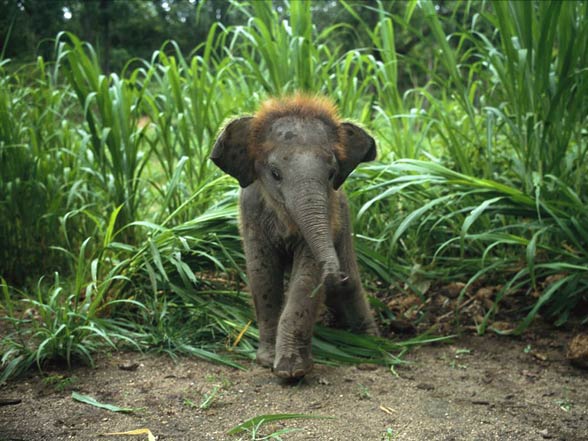
Asian elephant and human
For the most of the year, the Asian elephant is shy and timid when it comes to interaction with humans. However, solitary individuals are an exception, because they are able to attack pedestrians. The solitary elephants often inhabit areas near roads, which makes it difficult for people to travel. An elephant can easily trample a man or pine him to the ground with its tusks.
During musth, bulls are very dangerous, both for people and other animals. Trained elephants are secured with shackles at this time, in order to not to kill anybody while being enraged.
Extraordinary case – a carnivorous elephant…
There is a documented case of a female elephant that lost her calves in an accident involving farmers. Maybe there wouldn’t be anything extraordinary, if it wasn’t for the fact that after the traumatic and hurtful loss, the female saw humans as a threat, and then… food.
The change of approach indicated the deterioration of her mental state, which resulted in killing the female. After her death, analyses were made, which all indicated that the female fed on human flesh. This tragic history was described in several articles and shown in a documentary made by Animal Planet: World’s Deadliest Towns: Man-Eating Elephant.
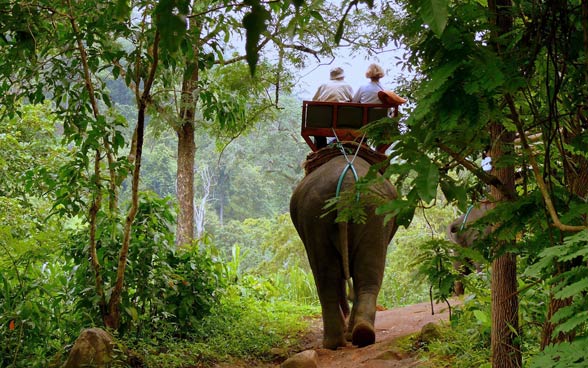
Training elephants
Both in the past and nowadays, Asian elephants have been trained in order to improve the effectiveness of human work. Supervised by the human eye, the animal moves heavy items, especially large trees that grow in the jungle. These animals are valued because of their capability of crossing difficult areas, and therefore, they become a natural jeep. Moreover, they are great means of transportation during a safari.
Talking elephant
A 22-year-old elephant named Koshik was able to articulate 6 Korean words. In an experiment, Korean native speakers were able to understand what Koshik had said. The elephant uttered the words with its trunk, which it put in its mouth, and modulated the timbre and rhythm of emitted sounds. Despite that extraordinary skill, experts have not believed that Koshik understood the words.

Detailed information and size
Asian elephant (Elephas maximus)
- Body length from the head to the tail: 5,5 – 6,5 m (18 – 21 ft), confirmed record 8,06 m (26.44 ft); unconfirmed record – 3.7 m (12 ft)
- Height at shoulders: bulls: to 2.75 (9 ft), record 3.43 m (11.3 ft), cows: to 2.4 m (7.9 ft)
- Tail length: 1,2 – 1,5 m (3.9 – 4.9 ft)
- Trunk length: 1,5 – 2 m (4.9 ft – 6.6 ft)
- Tusk length: 1,5 – 1,8 m ( 4.9 ft – 5.9 ft), record 2,4 m (7.9 ft)
- Tusk weight: to 47.4 kg (103.6 lb)
- Weight: 2 – 4 t (4,400 lb – 8,800 lb), record 7 tons 15,430 lb)
- Lifespan: 60 years in the wild, 80 years in captivity on average
- Ears: much smaller than in the African elephant
- Population: 39,500 to 43,500 in the wild
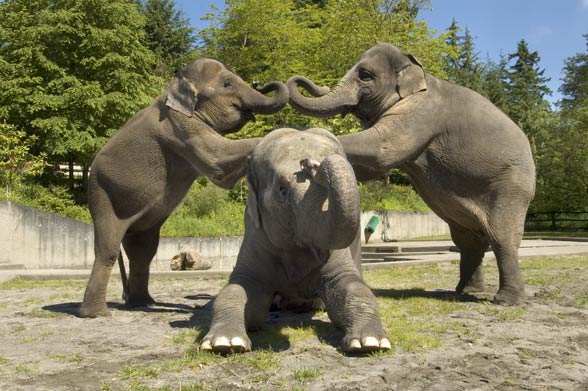
Asian elephant – interesting facts
- The largest Asian elephant in history was shot by the Maharajah of Susang in Assam (India) in 1924. The giant weighed 8 tons (17636 lb), its height at shoulders was 3.35 m (11 ft), and body length 8.06 m (26.44 ft) with the tail.
- The trunk consists of 60,000 muscle fibers.
- Because Asian elephants are great at manipulating their trunks, they can hold an item of the weight of 300 kg (661.38 lb).
- The trunk of the Asian elephant can contain about 4 l (1 US gal) of water.
- Females produce pheromones, which main component occurs in pheromones of numerous insect species.
